During a recent blog team outing with Joel Watson and Dave Hyde, the three of us remarked how lucky we are to have found a passion for a sport with such a tight-knit community. Football players or guitarists may work their entire lives or spend unimaginable amounts of money for a brief moment with their heroes. Yet as fly fishers, the legends of our craft are as easily accessible as a personal mentor or buddy. While the industry may seem dauntingly large at first, the truth is that fly fishers are a very cordial clan. Nowhere was this more obvious than the Marlborough Fly Fishing Show in mid-January.
As many of the world’s foremost fly fishers and tyers converged right here in Massachusetts, I figured I’d add to the endless stream of wide-eyed devotees bugging them for advice – and maybe even get a blog post out of it. The following is a collection of my conversations with nine fly fishing experts over the course of two days at the 2023 Marlborough Fly Fishing Show. Each expert was asked a series of four questions. Some questions were more typical and practical, while others were purely for fun. So if you’ve ever wondered what Tim Flagler’s favorite fishing method is, or what Emily Bastian’s first fish was, read on to find out!
Scott Biron
Instagram: @scottbiron

Scott Biron is an acclaimed classic featherwing streamer tyer from New Hampshire. His fascination with the history of fly tying is obvious in the beautiful and amazingly technical patterns he ties. I am fortunate to say that Scott actually taught me to tie flies a number of years ago at Barry Conservation Camp in Berlin, New Hampshire. Since then, I’ve always made a point of talking to Scott at the show. Likely stemming from his many years as a school gym teacher, Scott is the one of the most amiable and patient people out there.
Q: What do you think is the most underrated natural tying material?
SB: Squirrel tails. It was a material that was used a long time ago and was a staple. It’s got good movement in the water, and really, people don’t use it as much. It’s a little finicky to work with because it’s slippery. But if you learn how to not use too much and tie it in, it’s money on most fly patterns. You know, you can tie squirrel tail stimulators and a lot of streamer patterns. And there’s fly patterns like Dave Whitlock’s [Red] Fox Squirrel. People vacillate to other things, but these are the patterns that catch fish all the time.
Q: What is your favorite fly fishing or tying book?
SB: My favorite fly tying book is probably [Dick] Stewart and [Bob] Leeman’s Trolling Flies for Trout and Salmon that was written years and years ago. It’s got a couple hundred patterns in it, though most of them have kind of gone out of fashion. I have two of them; one of them is just falling apart because it’s always on my bench.
Q: Landlocked salmon or brook trout?
SB: Well, brook trout, they’re gold. I mean, I like them both, but I would gladly go brook trout.
Q: What is a classic fly more people should be fishing?
SB: So I’ll stay with my streamers, and say that something as simple as a Sharon that you can troll. You really have to count the bucktail strands and you can’t have more than eight of each color. Also, Gray Ghosts are always great, but they’re very popular. You know, different lakes have different flies that work, but I would say a Gray Ghost has stood the test of time.
Nate Wight
Instagram: @n.w.flyco

Born into a family of outdoorspeople and raised in the western Maine mountains, Nate is about as indicative of a Maine fly fisher as they come. Nate is a fourth-generation Maine guide, as well as one of the most talented fly tyers I’ve ever seen. While his Instagram may reveal his talent for whipping up creative and intricate nymphs, Nate’s true passion is big streamers – which he puts to good use on some honkin’ North Woods smallmouth, brook trout, and salmon. Nate is one of the most helpful people in the industry, always willing to answer any question you might have.
Q: What are the biggest and smallest flies you’ve tied?
NW: Smallest is a 32, and they don’t make 32s anymore. And the biggest I’ve ever tied on was an 8/0, but it’s a 14 inch muskie fly. Most of my striper flies are a lot smaller, like the 2/0s, 1/0s, sometimes I even step up to 4/0s.
Q: What is the most underrated fly tying tool?
NW: A thread splitter. Stonfo makes a thread splitter. I tie a lot with 30 denier gel spun for all my jig flies, and when I flatten that thread out, I just lay it in the tool, and the needle pops up through and it splits it perfectly. Saves a lot of time.
Q: What is the most underrated fish species?
NW: Being from Maine, I would have to say the fall fish. If you can tell me the difference when you hook up on a chub versus a brook trout right off the bat without seeing it, I would be surprised.
Q: What is one tying technique more people need to learn?
NW: Proper hackling, size of hackle. Go back and study how big your hackle should be on a dry fly. Don’t over hackle them, make sure that it’s a gap, gap-and-a-half in size, and stop over hackling. If you size your hackle correctly, you shouldn’t have to trim your hackle.
Jay Alward
Instagram: @handmade_angler
)
You’d be hard-pressed to find another Northeast angler as knowledgeable about fly fishing for bass as Jay. Like many of us Bay State anglers, Jay makes the most of our numerous angling opportunities, but has found his specialty throwing meat for warmwater predators. Jay’s flies are as functional as they are eye-catching; all are designed with a specific bite-triggering movement in mind. As much as fly fishers gravitate to salmonids and saltwater, Jay has proven that bass have a place in the sport as well.
Q: Smallmouth or largemouth bass?
JA: I love them both, really, but if I’m going to go out on my own, it’s probably going to be largemouth. I mostly fish for them in ponds. I like something small that I can really get to know well so that I can go fish it at night.
Q: What is your favorite fly fishing YouTube channel?
JA: I guess it would be Tightline Productions – Flagler.
Q: What is your favorite fishing method?
JA: I love them all so much. It could be topwater, it could be streamer fishing. I probably toggle between topwater and streamers. I tend to scale my streamers down a little bit. I’ll throw articulated stuff for bass. [One of my favorites is] a Gonga with a head that is blended Finnish racoon.
Q: What is your favorite hatch?
JA: I think my favorite hatch would probably have to be the Hendricksons or the Caddis … or Bluewings. I also really like fishing sculpins. And I really like later in the season when the young-of-the-year are just an inch-and-a-half long and you kind of get away with those small sparkly minnows and that kind of thing. I’ve been in crazy hex hatches on Lake Champlain, but I haven’t seen that around here [in Massachusetts].
Logan Messina
Instagram: @troutaboutit_flyfishing

Logan, a transplant from New York, has fully embraced the Maine fly fishing culture. Fairly new to the scene, Logan has proven his skill at cranking out flies at a lightning-fast pace. His perfectly proportioned, uniformly tied flies appear at the Rangeley Region Sports Shop and online at the Maine Fly Guys shop. Logan is a super chill dude, and a wealth of knowledge regarding western Maine fishing.
Q: What is your top tip for increasing tying speed?
LM: The preparation. Always pre-bead your hooks, and put the wire on ahead of time. Then do it in stages. I’m always pre-beading everything – it sets me up for the whole day. I’ll do six dozen pre-beaded and I’ll put them all on a piece of foam. Then I’m not questioning what I’m doing next or getting out hook bins. I just have them all set up for the day, or I’ll do it the night before and then wake up that morning all set. Otherwise I just tie one fly all the way through. Sometimes with [flies] like the floating smelts, I’ll do them in stages: put the eyes on, stop. Then do the tails. But most of the trout stuff is small enough where you can tie the whole fly all the way through. Also, make sure you’re comfortable in your seat and that your vise is at the right height. I actually keep [mine] low so that I look down on the vise; my shoulders are relaxed and I’m not reaching out.
Q: What is your favorite fly fishing or tying book?
LM: Good Flies by John Gierach. It has little pictures of the flies. It’s not like an instructional fly tying book, but it’s a great fly book. It breaks down the flies pretty intricately.
Q: Would you rather fish ponds or rivers for brookies?
LM: Oh, rivers; the ponds feel very mysterious. It’s not always guaranteed and it can be really tricky. I do like the ponds, but something about the rivers is just where my heart is.
Q: What is your craziest wildlife encounter?
LM: Well, I was snowboarding one time and I was in the woods. We hadn’t gotten a lot of snow and the conditions finally just started getting kind of crappy. But I went into the last little bit of open woods and went over this little boulder. I looked back, and there was a mama bear and cubs coming out of the den that I just literally jumped right over. I fell in a big pile of powder, and I looked up and they were right there. But fishing, I don’t know … I’ve seen a couple of bobcats out there.
Lou Zambello
Instagram: @mainelyflyfishing
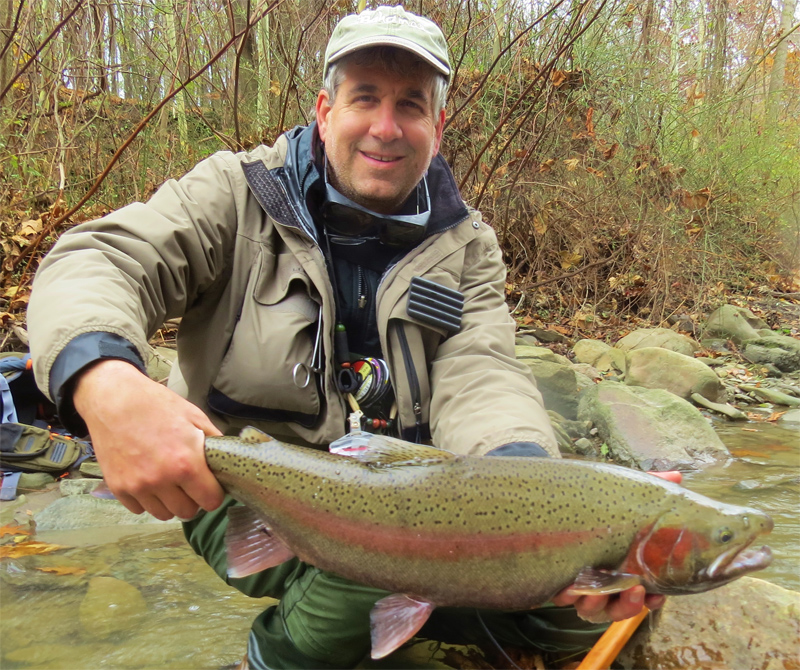
Lou is probably best known for his books on Maine and New England fly fishing, which are some of the most comprehensive sources out there. In addition to being a local expert, Lou has traveled extensively, typically with a fly rod in hand, building an impressive arsenal of fishing techniques. Unlike his witty personality, Lou is a blunt realist when it comes to weather; you can always trust his reports to be accurate, even when they are mildly depressing.
Q: What’s a piece of fishing gear more people should be using?
LZ: Most of the time the fish is near the bottom. Not enough people have the full number of options of gear to get their fly to the bottom. Everybody should have sinking line or a sink-tip line or a sinking leader so that they can get the fly down in big current. Most of the time people don’t catch fish because their offering is a bit higher in the water column from where the fish are. For ponds and lakes I like full fast-sink because I get too bored waiting. But in streams that are relatively shallow with some deeper pools I’ll use a sink-tip, or often I’ll use a sinking leader.
Q: Would you rather fish when it’s 65 degrees and peak blackfly season or 33 degrees and raining?
LZ: I will always fish during the blackfly or mosquito season because that means the humidity is correct for all sorts of emerging flies, including caddis and mayflies, so I know the fishing is better. I don’t think I’ve ever had a bad fishing day when the blackflies and mosquitoes are out. And I have apparel that I use to protect myself. If it was up to me, I’d have the black fly season the whole season.
Q: What destination is at the top of the list of places you want to visit?
So, [a place] that I haven’t visited: I would like to go north into Canada and fish for pike in some of the big northern lakes. I’ve been to New Zealand, Chile, and the Kola Peninsula in Russia, and while the Chilean fishing was outstanding, I really love New Zealand for the people and all the public water. So I would go back to New Zealand first, I think.
Q: What is the most underrated fish species?
LZ: I think whether it’s pickerel, pike, or muskie, I just think those are so much fun to catch. They just explode on the fly, and they fight hard for a little bit. And given that they keep spreading, I mean pike are everywhere now, I don’t know why more people don’t go after them. I think the most overrated fish is the bonefish. Yes, they run like crazy, but they’re not that big and in some places they’re pretty tough to catch. I think there’s a lot of other fish that run just like that that are easier to catch, are more widely available, and bigger. It’s almost impossible in a lot of places to catch a bonefish without a guide. And there’s other fish that I think are equally fun and you don’t need a guide. I’ll take a redfish over a bonefish anytime.
Tim Flagler
Instagram: @tightlineproductions
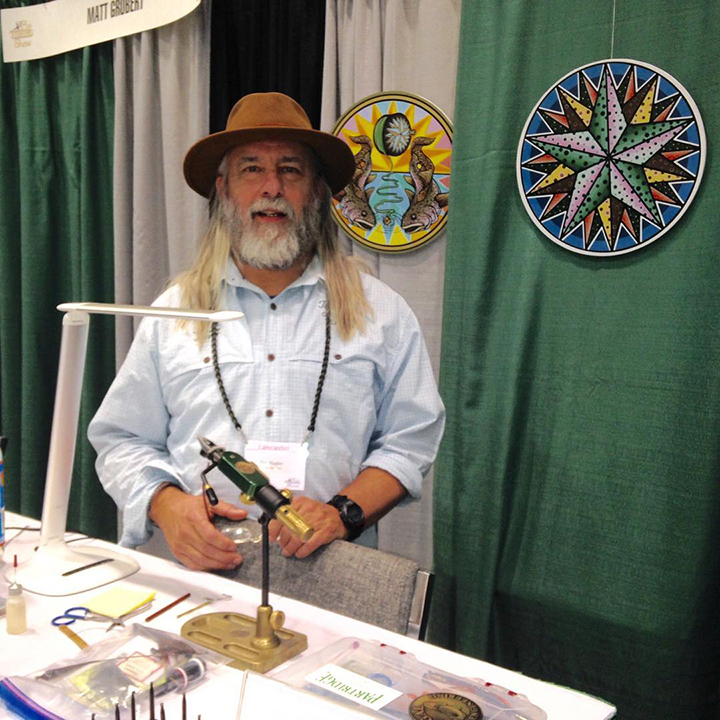
Tim may just be the most legendary fly tyer in the digital era. Though he lives in New Jersey, his YouTube videos have taught thousands of tyers around the world, across a vast range of ability levels (myself included). Despite his fame and expertise, Tim is extremely down-to-earth, able to meet you on whatever level you may stand.
Q: What is your favorite fishing method?
TF: Right now, it’s trout spey, without a doubt. When I guide and fish, oftentimes I’m euro nymphing now, and it’s super, super effective where I am in New Jersey, Pennsylvania, and southern New York. But in terms of relaxing and having a good time fishing, it is absolutely swinging; I love the two-handed stuff. You don’t have to cast a country mile when you’re doing it. It’s not like your championship spey casting. It’s mainly getting the equipment dialed, honestly more than the casting. The problem is, if you don’t have the equipment correct, any casting that you’re doing is like counterproductive practice because you don’t know whether it’s you or the equipment. And even just 20, 30 grains of the wrong line and you’re in the weeds. You could practice all day long and it’s not your fault, it’s just not the right gear. Having someone that knows, going to like a Spey Nation, Spey Clave, where they’re knowledgeable people about two hand, it’s absolutely key. Or better yet, take a course or a class with somebody that knows they can get your equipment dialed in. A lot of guys are using high-speed videography so everything is slowed down, and you can see just minute, little things in your cast.
Q: What is a piece of tying equipment more people should be using?
TF: I am going to say a whip-finish tool. There are two camps: there are the hand whip-finish guys, and I can hand whip-finish real well, dare I say more accurately than most people; but still, for accuracy, quality, tight knots, a good Matarelli whip finish tool is essential. To me, the Matarelli is just so much more accurate. Once you learn, it’s the way to go.
Q: If You could only fish one region for the rest of your life, like the Catskills or the Florida Keys, where would it be?
TF: Well, the first I’m not going to tell you about because I don’t want anybody else there. So I’d have to say Patagonia, Argentina.
Q: What is a conservation topic we should be paying more attention to?
TF: This isn’t really an answer for you, but I’m going to give you what I think. In New Jersey, where I fish, you’re close to Manhattan. There’s eight kajillion people. Opening day, it’s a fracas: bait fishermen, spin fishermen. The whole deal, all over the place. We need stocked trout. There are too many people that want to fish. And historically, it’s been this way for a couple hundred years. Everybody wants native fish, wild fish. We in New Jersey still have it. They figured it out genetically – it’s heritage-strain brook trout. They’re the original ones that were there back in the day. They don’t get very big. Most of the time they are way up in the feeders and headwaters. And a lot of times what happens is as they get bigger, they’ll come out and they want to be in the big rivers and a lot of them get eaten by larger, predatory fish. Maybe, just maybe, if we got rid of all the stocked rainbows and all the browns and all the tiger trout in the state – killed everything – it is very possible that those brook trout would come back. Nobody could fish worms for probably 10 years to get back to normal, which would cause all sorts of problems. But here’s the rub with that: at the same time, we have [wild] brown trout. The state doesn’t stock them. Yeah, some of the private clubs do, but for whatever reason, in the last five years, we started seeing really small, four-inch wild fish. They’re all up-and-down the South Branch of the Raritan River, the Musconetcong. And it’s like, where are these fish coming from? Even the biologists were like, “We don’t really know.” We’re getting fish that are 14 to 16 inches long. Brown trout. But the problem is, they’ve become really predatory fish and those heritage-strain brook trout could be a meal for them. So there was actually talk, in this state, of eradicating this wild, breeding brown trout population. So we finally have a sustaining population that doesn’t need to be stocked every year, and there’s talk of eradicating it. I understand the rationale for it, but it’s New Jersey; it’s not Wyoming; it’s not western Montana; it’s not northern Maine. So to me, we have to play by slightly different rules. It’s like them trying in all places up and down the coast to reintroduce Atlantic salmon. They were here historically, and you could spend millions and millions of dollars, but the chances of them coming back . . .
Bob Mallard
Facebook: Bob Mallard
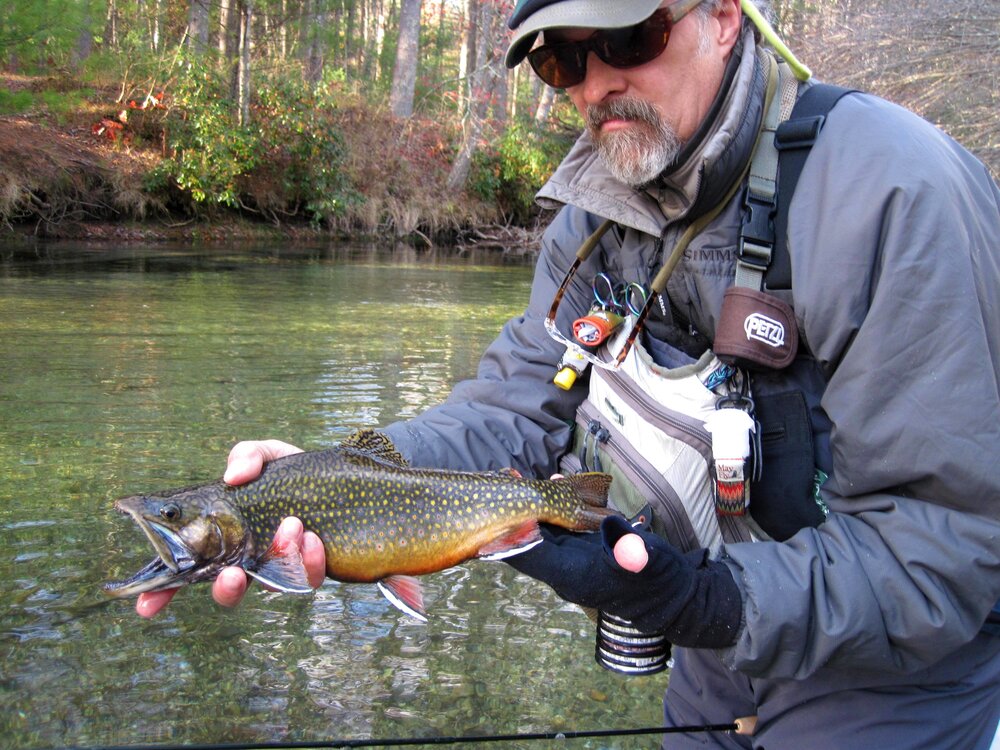
Bob, among other things, is a stellar fly tyer and designer, fly fishing guide, author, outspoken conservationist – and gusty talker. Given this final attribute, Bob’s short answers to my questions can only be explained by one thing: the incessant traffic seeking his company at the Native Fish Coalition booth, which he manned all weekend. Bob has used his position as Executive Director of the NFC to “make native fish cool again”. Love him or hate him, Bob has made an undeniable splash in the world of conservation and fly fishing.
Q: Would you rather fish ponds or rivers for brook trout?
BM: In my personal opinion, ponds. If you don’t fish them, you don’t know what they are.
Q: Most underrated fish species?
BM: Arctic Charr. They’re a better angling fish than people think, they’re super rare, so they’re a bucket list fish, no doubt.
Q: What destination is at the top of the list of places you want to visit?
BM: Iceland. For salmon and char.
Q: What is your favorite fly to tie or fish?
BM: Foam bugs.
Fred Klein
Instagram: @grizzlykingfly
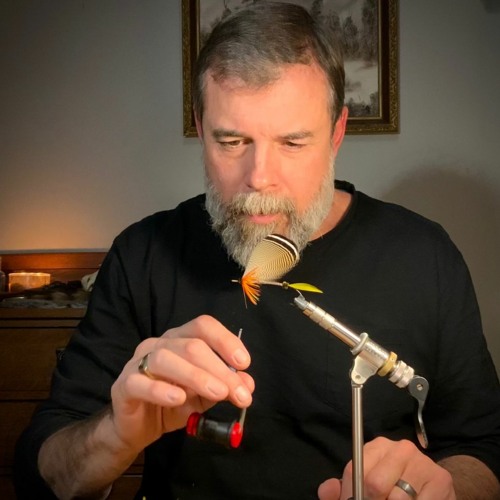
Fred lives and breathes tradition. Through his website, named after (spoiler!) his favorite classic fly, Fred shares his adventures delving into the history of the art of fly tying. And yes, art is the perfect word to describe Fred’s work, because his ties are outstandingly beautiful.
Q: What is your favorite fly tying or fishing book?
FK: My favorite fly tying book would be Mary Orvis Marbury’s Favorite Flies and Their Histories. It’s a beautiful work of literature. And actually, Fishing with the Fly by her father, Charles Orvis, was a beautiful work of literature and well-written. They didn’t include dressings or patterns; it was more stories about the flies. Actually, a lot of those old flies, if you look up the pattern, you’ll see the basic materials for it. And those illustrations were so well done. They actually hired an illustration company out of New York City because they didn’t use photography in books back then. It was all sketches or oil paintings, so they hired an illustrator in New York City. They did a phenomenal job; you can almost tell what the feathers are by looking at the painting. Whereas if you look at Ray Bergman’s book, he has all the dressings, but they kind of look like cartoon flies.
Q: What is a classic fly more people should be fishing?
FK: Everything I tie I fish, and I fish obsessively; and everything that I use is pre-World War II. So all these Ray Bergman and Mary Orvis [flies], even with the silk blind eye hooks and silk snells and twisted eyes, I fish those a lot. Constantly. And they do very, very well. It’s just a completely different style of fishing. It’s really an attractor. But when these are tied in smaller sizes they replicate many of the natural mayflies and caddis very well. They may not be as famous because they’re not as flashy. The flashy flies – like the Royal Coachman, the Alexandra, the Parmachene Belle – most of these tied in bigger sizes are minnow replicas and they’re attractor flies from the Victorian era. I think a lot of people would be surprised at how well they actually do. My favorite fly, that I’ve been fishing for probably about 40-45 years, and have done very well with is the Grizzly King. And you can tie it on a size 16 or 14 and replicate a mayfly or a caddis. Or when tied on a wet fly [hook] it could be an attractor small minnow. Or you could tie a large Grizzly King on a size 2 or 4 hook and it’s a big brown streamer, and they work. You have heavier hooks and lighter hooks; the hook takes the fly down in the water based on the size and thickness of the shank. Depending on how high your water level is or how much rain you’ve had, you choose the hook accordingly. So if it’s the middle of summer, you’re going to go with a real thin wire.
Q: If you could only fish one region for the rest of your life, like the Catskills or the Florida Keys, where would it be?
FK: Pennsylvania Appalachian Mountains. Pennsylvania has more miles of wild trout water in the United States of America, second to Alaska. And most of it is untouched. The river system that I live on, and the tributaries to it, most of them are Class A with wild brook trout and brown trout – very large brown trout. Most of it that I fish is completely unfished and not talked about. I think when a lot of people think of Pennsylvania, they think of Pittsburgh and Philadelphia. But most of Pennsylvania is very rural and wild. A large majority of Pennsylvania is covered by the Appalachian and Allegheny Mountains, and a lot of it is truly as remote as what I’ve seen in Maine.
Q: What is your favorite fly shop?
FK: My favorite fly shop is Melinda’s up on the salmon River in New York. She carries everything traditional: classic materials from silk to feathers, obscure things that you will never find anywhere else. It’s really a salmon fly tyer’s delight, and I just really enjoy it.
Emily Bastian
Facebook: Emily Bastian
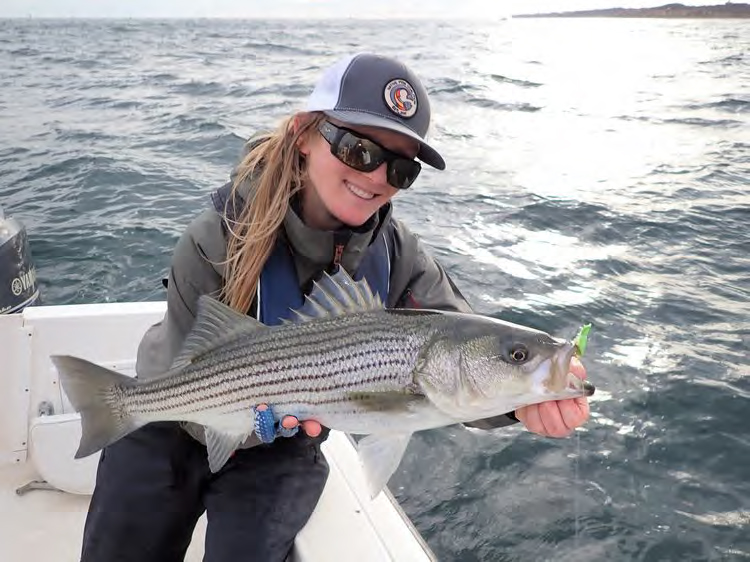
Emily is one smart cookie. It wouldn’t be unreasonable to say she was the most knowledgeable fisheries biologist and conservationist present at the show all weekend. As a founding member and current National Chair of Native Fish Coalition, Emily has been an integral part of bringing native, wild fish into the limelight. Emily is also a true Mainer and certified badass who’s not afraid to display her love for native fish through her flamboyant, brookie pattern leggings.
Q: Would you rather fish when it’s 65 degrees and peak blackfly season or 33 degrees and raining?
EB: 65 degrees and blackflies because I can wear a head net or I can smoke a cigar or use bug spray. And when the bugs are biting, the fish are biting.
Q: What is a conservation topic we should be paying more attention to?
EB: Protecting and preserving wild, native fish. They are an indicator of healthy aquatic ecosystems. When we have robust, healthy, self-sustaining populations of native fish it’s an indicator of a healthy habitat – and we need to do more to preserve that. The species that needs the most help is geographically dependent. By definition, the indigenous species of that area are the ones that are indicative of a healthy habitat. I guess you could look a little higher in the food chain – to those that are the keystone species – as an indicator species, because if you have those higher level species in the trophic cascade, then you’ve got other species below them. And not just fish; it trickles all the way down the food chain. Healthy aquatic ecosystems also support your aquatic insects, your native plants and birds and mammals, and everything. Everything from otters and eagles [to] beavers and loons is all interconnected.
Q: What is your favorite fishing method?
EB: Oh man, it’s a toss up. [I like] active streamer fishing: throwing them in a river, tossing streamers with a heavier rod and stripping fast for big fish. But right now, it’s small stream fishing with a six-foot two-weight rod, a lanyard and a fanny pack, tiny little net, light lines, and dry flies.
Q: Do you remember your first fish? If so, what was it and where did you catch it?
EB: The first fish I caught on a fly rod was in the Roach River in Maine when I was eight years old, and it was on a wooly bugger. Native brook trout from Moosehead Lake. That’s where I learned to fish, and I was fishing with my dad. It couldn’t have been a better place to learn to fish. So I consider myself very lucky.
Discover more from BlogFlyFish.com
Subscribe to get the latest posts sent to your email.

Great insight from some absolute legends. Awesome job, Spencer!
This is an outstanding article, Spencer. Great idea to interview the pros at the fly fishing show.
+1. Great post, Spencer!